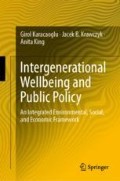Abstract
The primary purpose of this chapter is to explore the policy implications of the stylised model presented in the previous chapter. We first explore the steady state properties of three versions of the model, including one that reflects the outcomes of socially-optimal policies. Then, by way of demonstration of how the dynamics of the model works, we trace some of the interactions between wealth, poverty-reduction, social cohesion, environmental quality, output, technology, and overall wellbeing, through a few simple numerical simulations. Both exercises highlight a key theme of this book, namely, that when we are dealing with a multi-dimensional wellbeing function, policy makers will always be looking for policy interventions that have multiple and mutually reinforcing benefits. This will be a common theme across the examples that we present in Chaps. 4 and (in the form of numerical simulations) 6. Throughout these three chapters (i.e., Chaps. 3, 4, and 6), think of the policy question in terms of Fig. 1.2 in Chap. 1. The question is, which of the capital stocks that sit in the middle of the figure should we invest in, and how, towards expanding the “wellbeing frontier”; this is the primary policy concern of a “wellbeing state”. Each section of the current chapter has three sub-sections. First, a verbal and diagrammatic presentation of the core ideas. Second, a mathematical representation of the verbal and diagrammatic reasoning. Finally, a list of references (accompanied by a brief discussion) of the empirical literature that attempts to bring evidence to support or challenge the key assumptions of the theoretical model.
Access this chapter
Tax calculation will be finalised at checkout
Purchases are for personal use only
Notes
- 1.
Whether we set these policy-parameter values to zero or to an arbitrary minimum positive value does not affect the qualitative results presented here. \(\delta ^{j}\), \(\xi _{j}\), and \(\gamma _{j}\), for all j, are treated as fixed parameters for convenience.
- 2.
An important result highlighted in the Acemoglu et al. (2012) paper relates to whether government policy intervention needs to be temporary or permanent in nature, to incentivise the switch of production towards the use of clean technology, thus generating socially optimal outcomes. They show that a critical influence on this choice is the degree of substitutability between the clean and dirty technologies in the production of the final output.
- 3.
Conveniently, the dimensions of the Wellbeing Frontier in Fig. 1.2 can also be used to measure the success of policies, across time and countries, in expanding the frontier. The New Zealand Treasury has done some work in this area (see Sadetskaya 2014; Thomson 2013).
- 4.
See Acemoglu et al. (2012) for a rigorous derivation of this result.
- 5.
We want to acknowledge the assistance provided by Ms Thakshila Gunaratna in the calculation and diagrammatic representation of these numerical simulations.
- 6.
This is referring to the composition, as distinct from the scale, effects of poverty reduction on pollution.
Author information
Authors and Affiliations
Corresponding author
Rights and permissions
Copyright information
© 2019 The Author(s), under exclusive license to Springer Nature Singapore Pte Ltd., part of Springer Nature
About this chapter
Cite this chapter
Karacaoglu, G., Krawczyk, J.B., King, A. (2019). Wellbeing-Enhancing Public Policy. In: Intergenerational Wellbeing and Public Policy. Springer, Singapore. https://doi.org/10.1007/978-981-13-6104-3_3
Download citation
DOI: https://doi.org/10.1007/978-981-13-6104-3_3
Published:
Publisher Name: Springer, Singapore
Print ISBN: 978-981-13-6103-6
Online ISBN: 978-981-13-6104-3
eBook Packages: Economics and FinanceEconomics and Finance (R0)

